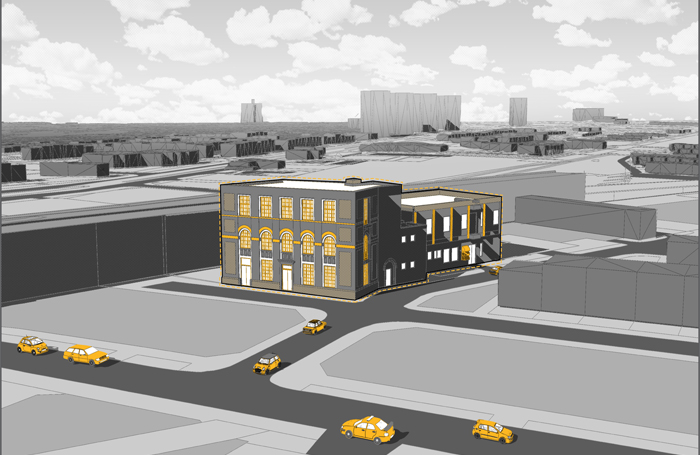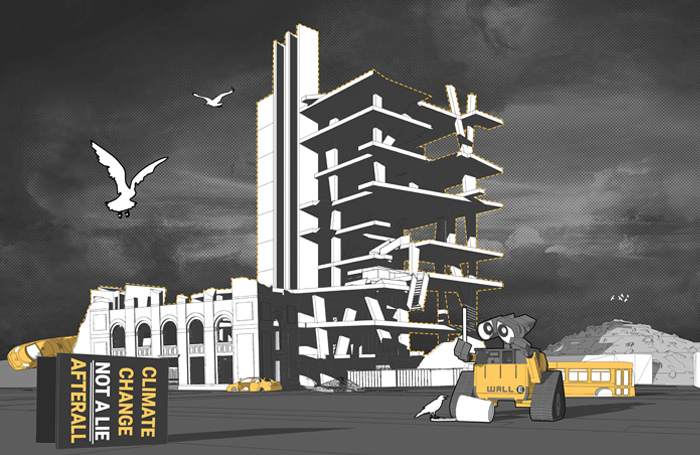Part 1 Architectural Assistant Zafir Ameen explores the potential of Space Based Solar Power to solve the climate emergency in his thesis project, The SOL-R Centre.
In order to reverse the catastrophic effects of climate change, Zafir argues that we must find a way to efficiently, yet sustainably generate energy. Space-Based Solar Power (SBSP) offers a solution: using satellites in space to harvest solar energy.
Previously explored by NASA in the 1980s, SBSP was halted due to technological limitations. With the exponential development of technology, now is the ideal time to invest in this power source. Moreover, with the ongoing Brexit uncertainty, the UK is in desperate need to promote both industry and research.
Collyhurst, North Manchester, once had a rich industrial history, though little evidence remains today. The area suffered due to a post-war industrial shift, causing a sparsity of residences. This scheme aims to amalgamate the two: providing Collyhurst with a new industry, and the UK with a pioneering research centre to explore SBSP.
Collyhurst, therefore, is put at the forefront of this technology, becoming the test subject for SBSP. The SOL-R Centre will no doubt become a pivotal aspect of Collyhurst and indeed Manchester, helping to rejuvenate the area.

The SOL-R centre is a seamless 11-storey amalgamation of research and education. The main tower is connected to the renovated portion of the Telephone Exchange, now serving as a new café and social space. The main building, however, revolves around various labs and cleanrooms, each designed to offer both specific and generic functions. These spaces are interlinked via a meticulous route that takes the public from the initial research all the way to the satellite communication room. This allows the public to develop an understanding into the importance of both research and the environment.
The building promotes a sense of intrigue through the complex circulation. A series of sub-levels also allow it to achieve more interesting spaces, offering additional views into the labs.
.png?rev=52c3419fe3ae443fa8610f9a77e62c18&h=800&w=700&la=en&hash=66A929DE921116B45DDC585BDDACA086)
The building’s form and circulation-driven design draws inspiration from the work of the Office of Metropolitan Architecture (OMA) and MVRDV, a Netherlands-based architecture and urban design practice.
The tower features a striking double-skin glazed façade that offers a subtle glimpse to its programme. The frosted second skin, however, ensures the public have to step inside to truly appreciate the interior spaces.
The main construction material is ashcrete, a substitute for traditional concrete where 97% of the components are replaced with recycled elements (predominantly fly-ash). Meanwhile, the existing façade of the Telephone Exchange was retained to maintain familiarity of the site. Moreover, the existing warm red-brick frontage complements the cold ashcrete tower.
.png?rev=a6bd1ee1d6334e76b47b4386b3bb9489&h=455&w=700&la=en&hash=D8232CD74085CB72822D3DC6FAB045D1)
The SOL-R Centre can be best evaluated across time, with its role adapting through a series of phases. These range from the existing Telephone Exchange (Phase 0) through to its future projection (Phase 8).
As the phases progress, the building’s programme becomes more refined, starting as a sole research centre and evolving to also showcase and educate the public.
When successful, the research will enable satellite transmission that converts the solar energy in space into microwaves. This is received at a rectenna site adjacent to the building, which will convert the microwaves into electricity to power both the SOL-R Centre and the surrounding community.
.png?rev=e298f2f507a246b386bd2435cbe73074&h=455&w=700&la=en&hash=4528740A8B0DA2C5D3CCFCBB2E5A62CD)
SBSP is advantageous due to its 24/7 capacity to generate energy. Furthermore, experts suggest the industry could be worth over $1 trillion, and create numerous job opportunities.
The success of the scheme will enable additional interest, revenue and visitors to the site, which will rejuvenate Collyhurst in the long-term. This utopian vision could easily extend out of Manchester, being adopted by the rest of the UK or even the world. The dire effects of climate change are already becoming irreversible, resulting in our inevitable dystopian future. We must act now to save the planet, and SBSP is the solution.
Zafir Ameen's project was submitted as part of RIBA Future Architects; our network and community for future and emerging architects, designed to support, inspire and provide a voice as you transition from study to practice. View our resources here.










